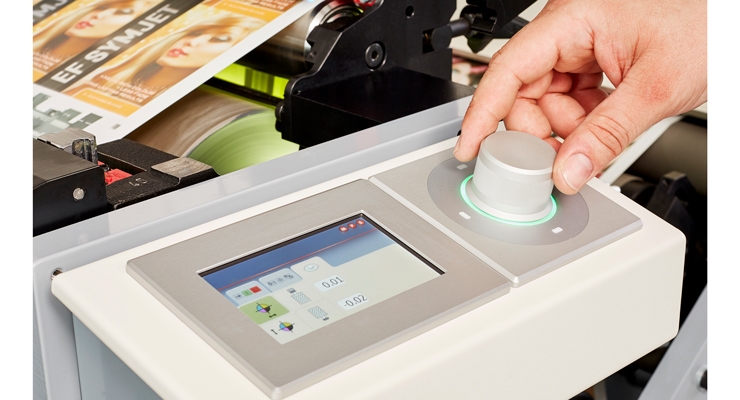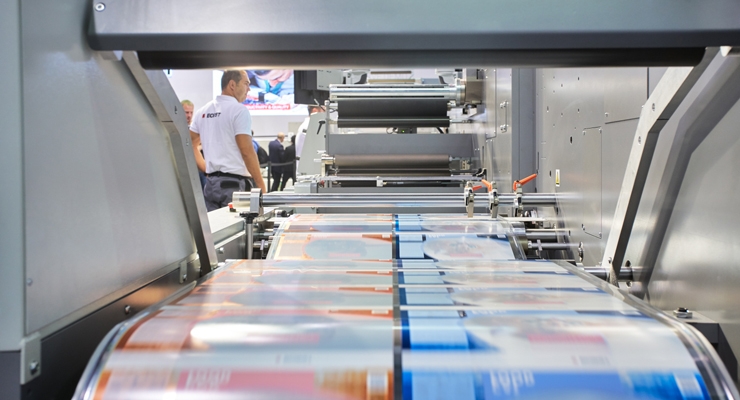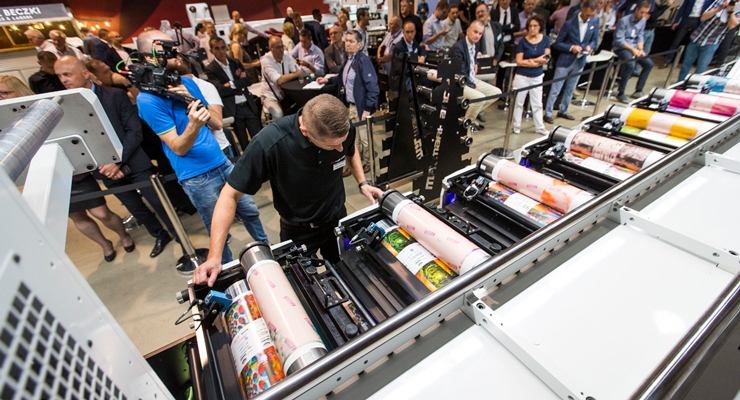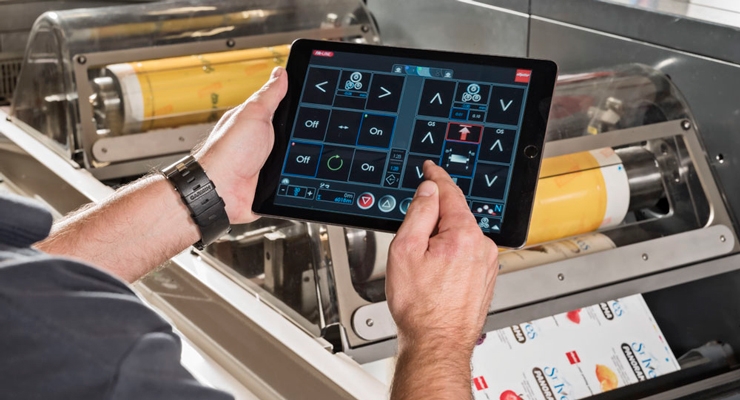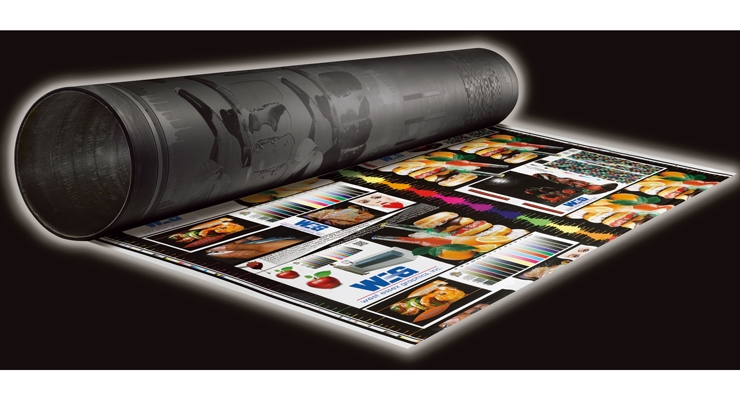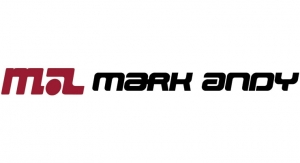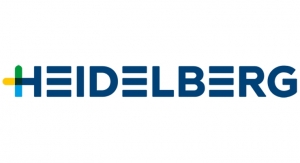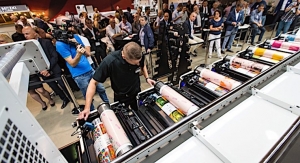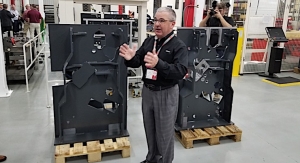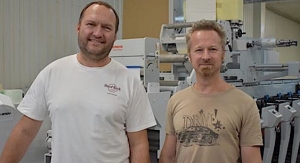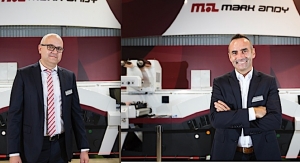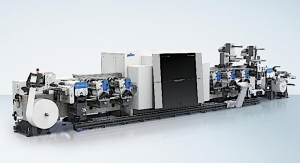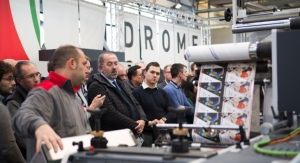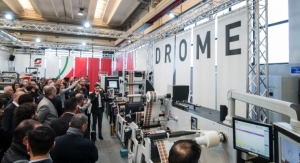Greg Hrinya, Associate Editor04.05.19
Digital has been positioned as the printing method of the future, but it is important to note that flexography – which still accounts for the vast majority of labels and package printing – has taken the necessary steps to evolve.
Flexo is not static. In fact, press manufacturers have gone to considerable lengths to make the technology more enticing to the next generation of printers. With some 90% of printing done flexographically, and label printing growth remaining strong at around 5%, there is still a robust future for this conventional printing method.
“With the evolution of Industry 4.0 and the age of automation, conventional press designs have gone through quite a transformation,” explains Paul Teachout, Nilpeter’s vice president of sales and marketing, North America. “No longer are there concerns of line shafts, gear boxes, plate shafts, bearers and gears. These are all things of the past. No longer does the converter need to worry about inventorying and maintaining all these parts with a workforce that doesn’t understand their importance to repeat good production. Today’s presses are based off automation that can capture data and repeat performance. This allows any press operator of any age or generation – and regardless of skill level – to have predictable results. This level of technology allows you to reduce your make-ready and waste by doing more with less. One press will easily replace two and do it at a higher quality, speed and efficiency.”
“There is, and will always be, a place for flexo,” says Jeff Cowan, director of business development, Performance Series, at Mark Andy. “Even as digital continues to gain momentum, the continued advancement in modern flexo technology, with a focus on high productivity, ensures its place in pressrooms worldwide.”
The rapid advancement of flexo technology is designed to meet a new workforce, one that is savvy to automation and intuitive controls.
“Finding the next generation of flexo press operators is a huge industry concern,” adds Todd Blumsack, vice president of Business Unit Web-fed, Bobst North America. “As a matter of fact, I sit on the TLMI Workforce Development Team, and this is the key topic that we’re addressing. With REVO and automation, Bobst is working to reduce waste and operational costs, all while making the equipment easier to use.”
Flexo is still the economical choice for long runs. The ability to replicate higher qualities at fast speeds will continue to drive press development. “Flexo printing is a great choice if you require a higher volume order,” says Hans Poortinga, manager of the MPS Technology and Expertise Center in Arnhem, the Netherlands. “Since flexo printing presses run at much faster speeds than digital presses, it is an efficient way to produce large volume runs with high-quality results. Also, the cost per label decreases substantially as your quantity increases.”
The hardware and software have improved to a place where inline printing and converting offer improved flexibility. New presses, such as the Gallus Labelmaster, allow for diecutting at any position, making it easier to produce multilayer labels.
“Flexo machines are available for a good price-performance ratio all over the world,” notes Matthias Marx, head of marketing at Gallus. “The flexo printing process is still a very cost-effective printing process, with an excellent print quality at an unbeatable printing speed. This makes flexo very economical for mid and long runs. Consumables are available for reasonable prices, too, and flexo offers solutions for different applications on different substrates such as low migration and water-based flexo.”
In the case of MPS, the company has developed an intuitive system based on automation. Its “Talk to Me” function is a connectivity platform that links a flexo or hybrid press to all other equipment and MIS or ERP software. MPS is striving for real-time insights in job management and press performance, prepress automation, shorter setup times, and more reliable print results.
Omet, meanwhile, offers print impression pre-settings, a computer control pad, register pre-settings and job storage data to improve the flexo printing experience. New ink technology has also led to vibrant graphics that allow a product to stand out on the shelf. “The use of UV LED inks allows for faster running speeds, 100% ink color consistency, full deep curing, all resulting in less waste and effective production speeds,” says Kaity Kelley, marketing assistant at Omet. “The operation costs with flexo are significantly lower than other printing methods.”
Most modern flexo presses are not seen as competition for the latest digital offerings, either. On the contrary, they can work in tandem to enhance any converter’s operation.
“We see UV inkjet technology as a direct complement to our process,” says Teachout. “There will be a day in the not so far future where flexography and digital solutions coexist on a daily basis. They both have their strengths and weaknesses and neither will replace the other.”
According to Teachout, 75% of new narrow web press sales will include some level of hybrid configuration by 2022.
Here are some of the latest flexo press offerings on the market today:
Bobst
Bobst, headquartered in Switzerland and with flexo label press manufacturing in Italy, offers presses that have been engineered with the newest technology. By adding digital processing, Bobst’s new presses are completely automated. The new M5 line, which features Bobst Digital Automation, yields 20 meters of waste with one minute for each job change, all while providing high quality and consistency. Other features of the M5 press include Digital Flexo 4.0, DigiGap, and DigiMount, which enhances plate mounting. ExcelCut and ExcelDie are available for the automated exchange of flexible dies and magnetic cylinders.
“We’ve always addressed market trends and delivered on challenges and needs from our clients,” says Federico D’Annunzio, strategic products marketing director, Bobst Business Unit Web-fed. “We also have a record of anticipating market changes by introducing new, innovative developments and concepts that move away from conventional design and build towards the future of the printing industry.”
In addition, to the M5 line, Bobst offers presses ranging from the M1 to the MX lines. Recently, the company launched the M5X line and the M8. The M5X provides a competitive investment cost to go along with short delivery times. The M8 has the advantages of the new X-Flower automated print sleeve exchange and REVO Digital Flexo technology. It also comes with the option of ink types, drying systems, and reel-to-reel or reel-to-sheet delivery.
According to Blumsack, automation, REVO technology and the ability to reduce waste and operational costs are all hallmarks of Bobst flexo presses.
Bobst has already seen success locally, with the Revere Group, based in Seattle, WA, USA, installing two presses: an M5-370 label press and the M5-630 film press. Both presses came equipped with custom engineering, and the Revere Group opted for turrets on the ends to deliver nonstop printing for longer run jobs.
Gallus
Gallus, based in Sitzerland and part of Heidelberg, offers both digital and conventional presses. For flexo, it offers the Gallus Labelmaster, launched to the market at Labelexpo in 2017 and offers enhanced flexibility. The Labelmaster comes in two offerings: Basic and Advanced.
“The basic version of this printing platform consists of preconfigured modules and offers a unique price-performance ratio. Even the basic version of the Gallus Labelmaster offers a high degree of flexibility, because an optional print process change is available in every position,” says Martin Kast, head of product management at Gallus. “The Advanced line convinces with maximum flexibility and a high degree of automation. The standard integrated longitudinal and transverse register controls can be fully combined with all equipment features in this model line. The Gallus Labelmaster Advanced offers the highest level of process variability, meaning that the various printing and finishing units can be changed quickly and easily by the operator in any position of the machine, in just a few minutes.”
Gallus also offers the RCS 430, ECS 340, TCS 250, and the EM-S-Series. As a modular inline press with direct drive technology, the Gallus RCS 430 can be configured and extended seamlessly. It also features dynamic feed, pre-settings for web tension, length register and cross-register, and automatic washing units. The Gallus ECS 340 is the bestselling label press in its class, adds Kast. More than 560 presses support label printers all over the world. The Gallus EM-S-Series can be used to produce self-adhesive and monofoil labels, as well as a wide range of other products up to a width of 510mm.
“All Gallus machine systems have one thing in common: the modular structure and the changeability of the printing processes on the production level,” says Kast. “This makes Gallus presses quite unique in the industry. Gallus process changes always take place on the production level and are thus fully integrated into the control system. A further advantage of the positioning of all printing processes on the printing level is that the processes are solidly and stably integrated into the machine and can use the existing curing units.”
Mark Andy
While Mark Andy, based in Chesterfield, MO, USA, continues to develop solutions to meet short-run digital demands, the company’s award-winning Performance Series product line comes with a simple design that enables fast changeovers and waste savings. The newest line of Performance Series flexo presses has been designed with AI packages to support Industry 4.0 demands for enhanced automation.
“The latest generation of Performance Series presses has been driven by in-depth research and conversations with converters. Performance Series E is a result of a need for more automation, business diversification and higher quality flexible packaging on narrow web presses,” says Cowan. “One of the reasons we believe the P-Series continues to see success is our customer-oriented engineering team. They provide converters with the flexibility they need to increase profitability while also growing their business with less capital equipment.”
The new Mark Andy P9E press supports a wide array of applications and substrates, including flexible packaging, shrink sleeves, expanded content labels and more. The press is available in web widths of 13", 17", 22" and 26", and it runs at a maximum speed of 1,000 fpm. The press’ intuitive features have optimized it for the future, the company says.
The market has also validated the Performance Series line, as Mark Andy has about 1,000 presses in production, including the P9E, as well as the P7E, P5E, P4 and P3 presses. “Our engineers and designers have focused on improvements to provide a more automated control system, faster press setup times and higher max press speeds,” explains Cowan. “Key to it all is that we did this without compromising on the machines’ simplicity, reliability and flexibility to increase operator productivity and business profitability.”
According to Mark Andy, Performance Series customers are consistently reporting 60% faster changeover times and a 50% reduction in their material waste compared to legacy flexo technology.
MPS
MPS, a press manufacturer with headquarters in the Netherlands and a North American organization based in Green Bay WI, offers a variety of flexo, offset and hybrid presses. The company’s flagship flexo press, the EF, is a versatile and highly automated machine. It is available with three levels of automation: Basic, APC (Automated Print Control) package, and APC Advanced package. MPS designs and builds its presses with the operator in mind, the company says. “Operator Focused, Results Driven” is MPS’ philosophy.
MPS’ press line includes the EF, EXL-Packaging, which is a mid-web packaging press, EXL-Offset, an offset combination press, and the EF SymJet, a hybrid combination of MPS’ EF flexo platform with a fully integrated Domino N610i digital inkjet unit.
“With all the industry talk about digital, it is important to mention that digital is not always the right technology,” says Inge Brinkman, content manager at MPS. “Sometimes flexo is just the better fit, as it is more cost-efficient on longer runs. Digital is especially suitable for shorter runs and variable data. But on the other hand, you sometimes need longer runs, where flexo can be the best technology to use.”
MPS has taken steps to ensure that resources are available for future press operators. “We know it is becoming harder and harder to find and keep skilled operators,” explains Brinkman. “Therefore, we think it is important to offer training, which we do with means of the MPS Academy. Training is crucial if you want to keep people motivated. The industry needs to try to motivate young people to join the flexo industry by informing them about the job opportunities and offering education.”
Nilpeter
Nilpeter has developed a wide range of flexo presses, most recently launching the all new FA press. The all new FA has been built to meet the ever-growing needs of the converter, both in operation and functionality. It is constructed with a modular design, where it can be offered at many different levels of automation and applications depending on a company’s current and future needs.
“We are constantly hearing from our partners that the workforce challenge and finding skilled labor to run their production is a major concern,” says Teachout. “This was taken into deep consideration during the development of the all new FA press. We knew we had to provide a solution that addressed these concerns. The all new FA is a fully automated press with single component operation, single piece inking system, anilox and plate sleeves. The press comes with Clean Hand technology and is operated with a tablet. It is a smart press to engage with today’s modern operator. This innovative technology attracts a younger workforce raised on disruptive technologies.”
The frames of the Nilpeter press are all single piece steel construction, where the entire module is machined through automation all at once to maintain the tightest tolerances. The entire print station can be exchanged in less than 30 seconds, too.
“Utilizing the job save and recall functions, make-readies are done through automation, saving tremendous amounts of time and materials regardless of operator skill,” adds Teachout. “There are no more knobs or handles on the front of the press. Anything an operator could pull, push or twist is now captured and recorded by seven motion control motors per station. All this is managed with smart tablet controls and Clean Hand operation. This entire methodology is designed throughout the all new FA platform for printing and converting.”
Omet
Omet, a press specialist based in Lecco, Italy, offers a wide range of presses, including the iFlex, XFlex X4, XFLex X5, XFLex X6.0, XFLex X6 Offset, XJet, Varyflex, Varyflex V4 Offset. The XFlex X4 offers a shorter web path and smaller footprint to go along with upgradeability for changes and regulations. The overall consistent printing results are designed to satisfy all converters who rely on print cylinders. Meanwhile, the XFlex X5 is a fully servo-driven press with servo printing stations, servo-motors on the outfeed and then diecutting. The “Easy Change” system provides low waste levels, faster setup times and reduced run-to-register time for a true operator-independent performance.
“Omet’s made-in-Italy machines combine ease of use, low waste levels, reliable non-stop operation and efficiency on shorter runs,” says Kelley. “Robustly built and inherently safe to operate, Omet’s printing machines are built around the ‘platform’ concept, which refers to the possibility to set inline a whole array of printing, finishing and converting technologies to print any product in one pass. Omet package printing machines support its customers’ growth, boost their efficiency, and can be adapted to suit any changing or future need.”
Omet has been instrumental in promoting flexography to the next generation of printers, too. Omet has worked with high school and college programs, such as the Phoenix Challenge, as well as started its own program, “The Future of Flexo.” The company has donated to several university programs such as The Sonoco Institute at Clemson University. Omet’s Varyflex 530 narrow web press installed at Clemson allows students to experience hands-on learning in the basics of press operation, color management, process control and more. The press is located in the Institute’s Advanced Print Lab, which also houses ink and plate processing equipment. Omet has also supported Illinois State University courses and activities.
“We need to keep our youth interested and exposed to the flexo world,” says Kelley. “The sooner they are introduced to this industry, the better off the future of our industry looks. Hosting a career day, supporting existing flexo-related classes, and encouraging new flexo-related classes in high schools are some examples to get our next generation interested.”
Retroflex
With headquarters in Wrightstown, WI, USA, Retroflex offers inline flexo presses, as well as stack and central impression equipment. The machines are available in standard designs or as customized versions to provide printers and converters with equipment that suits their particular needs.
“After 27 years of designing flexographic presses, Retroflex has compiled a great deal of experience in the area of custom-designed printing equipment and web handling that we can offer a prospective buyer,” explains Kristin Broman, customer service and marketing at Retroflex. “We are more than willing to work with other OEM’s to be sure each section of the line has equipment that meets the needs of the application. If it’s a company the buyer has had great success with in the past, such as a specific dryer company, UV curing, unwinds, rewinds and so on, we will work with those chosen OEM’s to integrate our printers with their equipment.”
Retroflex equipment is available in manually operated, low budget versions, as well as high-end, full servo, all sleeve, touchscreen operated models. Retroflex has manufactured flexo presses from a few inches wide to 150" wide, reaching actual production speeds over 3,000 fpm while handling high tension and very low tension substrates.
“For Retroflex to meet customer expectations, we can provide features such as sleeved anilox and plate rolls, quick change chambered doctoring systems, wash up systems, all servo drives to each individual print station, as well as all servo impression control, full auto unwinds and rewinds and the latest in drying/curing technology,” adds Broman.
By Ryan Dufour, Senior Account Manager for West Essex Graphics
In the flexographic printing industry, there exists a necessary but often misunderstood technology: continuous print sleeves. Though often a requirement for full coverage, many printers and prepress providers have devised inventive methods to avoid using them, such as adding another color to press runs to hide gaps in print, performing elaborate cuts to nest images together and altering customer art from its original intent.
There are two main reasons for these workarounds. The first is cost, as most continuous print sleeves cost, on average, three times more than traditional flat mounted plates. Depending on the size of the print run, this investment can be challenging to recoup. The other is misconception, typically comprised of misunderstanding of the technology or, logistically, lack of knowledge on how to procure suitable print sleeves, since the number of companies producing them has dwindled significantly.
For almost 20 years, my career involved providing the flexo industry with photopolymer printing sleeves. My niche was born of a need for continuous print in the retail and decorative markets, and grew into a business of backgrounds, tight register jobs and difficult bounce items. Sleeve technology lends itself to each of these scenarios due to its continuous background images, its ability to integrate materials conducive to complex or difficult press conditions and, of course, the fact that it eliminates the need for mounting plates.
Throughout my tenure in this business, I was proud to offer “the good kind” of print sleeves. Photopolymer continuous print sleeves were – and in many ways still are – known as preferable to their primary competitor, elastomer sleeves. While the photopolymer sleeves enjoy a respectable reputation, their elastomer counterparts – frequently (and often erroneously) referred to as “rubber” – were seen as less effective, lower quality substitutes that provided inferior print quality.
I now find myself in a different role, providing prepress services and plates to the market. With this change, I have had to adapt and educate myself on the elastomer side of sleeves. For many years, I shared the belief that the materials and quality of elastomer sleeves were lower quality than their photopolymer counterparts. I have come to find that this was a misguided perception.
It’s myth busting time: The widely-held belief that elastomer sleeves are composed of a natural rubber – which in turn is typically associated with poor durability and low print quality – is, quite simply, false. They are actually made up of… well… a whole bunch of materials. And herein lies their genius. Elastomer print sleeves are made up of any combination of high-tech materials that, in fact, are highly customizable to fit specific printing needs. Whether a printer is prioritizing ink laydown, long plate life or quality half tones, print sleeves composed of elastomer materials can meet a broad range of press needs. And with such a wide variety of material combinations available, each elastomer sleeve can be produced to fit tailored needs.
Misconceptions in any industry are common. But complete misunderstandings are a rarity. And the truth is that the reputation of elastomer print sleeves as cheap, mass-produced items couldn’t be further from the facts. While there are, of course, sleeves made with rubber, the vast majority are composed of high-tech polymers and binders that yield long plate life, smooth ink transfer and the benefits of a continuous background.
Additionally, advancements in compounds and imaging technology have made various materials used in elastomer sleeves competitive to polymer in both price and performance. Elastomer materials also have become increasingly versatile, resistant to damage from various inks, and available in wider and larger press sizes. Also, owing to their more customizable nature, elastomers print sleeves can be specially designed to achieve different repeats that are harder and costlier to execute using polymer sleeves.
Many of my former customers have now switched to elastomer-based sleeves. Of these, exceedingly few have reported any decrease in quality or printability and, on the contrary, many have experienced longer plate life thanks to the high-quality components and a manufacturing process inherent to elastomer sleeves. While the sleeves may look slightly different from each other, they function nearly identically to polymer sleeves and, in some cases, even outperform them.
During my 25 years in the printing industry, I have seen continuous print sleeve technology change on a number of levels. From base materials, ease of use or the elastomers themselves, sleeves have become a mainstay in flexo press rooms. Now is the time to take another look at how elastomer printing sleeves could improve both the quality and bottom line of printing operations.
Flexo is not static. In fact, press manufacturers have gone to considerable lengths to make the technology more enticing to the next generation of printers. With some 90% of printing done flexographically, and label printing growth remaining strong at around 5%, there is still a robust future for this conventional printing method.
“With the evolution of Industry 4.0 and the age of automation, conventional press designs have gone through quite a transformation,” explains Paul Teachout, Nilpeter’s vice president of sales and marketing, North America. “No longer are there concerns of line shafts, gear boxes, plate shafts, bearers and gears. These are all things of the past. No longer does the converter need to worry about inventorying and maintaining all these parts with a workforce that doesn’t understand their importance to repeat good production. Today’s presses are based off automation that can capture data and repeat performance. This allows any press operator of any age or generation – and regardless of skill level – to have predictable results. This level of technology allows you to reduce your make-ready and waste by doing more with less. One press will easily replace two and do it at a higher quality, speed and efficiency.”
“There is, and will always be, a place for flexo,” says Jeff Cowan, director of business development, Performance Series, at Mark Andy. “Even as digital continues to gain momentum, the continued advancement in modern flexo technology, with a focus on high productivity, ensures its place in pressrooms worldwide.”
The rapid advancement of flexo technology is designed to meet a new workforce, one that is savvy to automation and intuitive controls.
“Finding the next generation of flexo press operators is a huge industry concern,” adds Todd Blumsack, vice president of Business Unit Web-fed, Bobst North America. “As a matter of fact, I sit on the TLMI Workforce Development Team, and this is the key topic that we’re addressing. With REVO and automation, Bobst is working to reduce waste and operational costs, all while making the equipment easier to use.”
Flexo is still the economical choice for long runs. The ability to replicate higher qualities at fast speeds will continue to drive press development. “Flexo printing is a great choice if you require a higher volume order,” says Hans Poortinga, manager of the MPS Technology and Expertise Center in Arnhem, the Netherlands. “Since flexo printing presses run at much faster speeds than digital presses, it is an efficient way to produce large volume runs with high-quality results. Also, the cost per label decreases substantially as your quantity increases.”
The hardware and software have improved to a place where inline printing and converting offer improved flexibility. New presses, such as the Gallus Labelmaster, allow for diecutting at any position, making it easier to produce multilayer labels.
“Flexo machines are available for a good price-performance ratio all over the world,” notes Matthias Marx, head of marketing at Gallus. “The flexo printing process is still a very cost-effective printing process, with an excellent print quality at an unbeatable printing speed. This makes flexo very economical for mid and long runs. Consumables are available for reasonable prices, too, and flexo offers solutions for different applications on different substrates such as low migration and water-based flexo.”
In the case of MPS, the company has developed an intuitive system based on automation. Its “Talk to Me” function is a connectivity platform that links a flexo or hybrid press to all other equipment and MIS or ERP software. MPS is striving for real-time insights in job management and press performance, prepress automation, shorter setup times, and more reliable print results.
Omet, meanwhile, offers print impression pre-settings, a computer control pad, register pre-settings and job storage data to improve the flexo printing experience. New ink technology has also led to vibrant graphics that allow a product to stand out on the shelf. “The use of UV LED inks allows for faster running speeds, 100% ink color consistency, full deep curing, all resulting in less waste and effective production speeds,” says Kaity Kelley, marketing assistant at Omet. “The operation costs with flexo are significantly lower than other printing methods.”
Most modern flexo presses are not seen as competition for the latest digital offerings, either. On the contrary, they can work in tandem to enhance any converter’s operation.
“We see UV inkjet technology as a direct complement to our process,” says Teachout. “There will be a day in the not so far future where flexography and digital solutions coexist on a daily basis. They both have their strengths and weaknesses and neither will replace the other.”
According to Teachout, 75% of new narrow web press sales will include some level of hybrid configuration by 2022.
Here are some of the latest flexo press offerings on the market today:
Bobst
Bobst, headquartered in Switzerland and with flexo label press manufacturing in Italy, offers presses that have been engineered with the newest technology. By adding digital processing, Bobst’s new presses are completely automated. The new M5 line, which features Bobst Digital Automation, yields 20 meters of waste with one minute for each job change, all while providing high quality and consistency. Other features of the M5 press include Digital Flexo 4.0, DigiGap, and DigiMount, which enhances plate mounting. ExcelCut and ExcelDie are available for the automated exchange of flexible dies and magnetic cylinders.
“We’ve always addressed market trends and delivered on challenges and needs from our clients,” says Federico D’Annunzio, strategic products marketing director, Bobst Business Unit Web-fed. “We also have a record of anticipating market changes by introducing new, innovative developments and concepts that move away from conventional design and build towards the future of the printing industry.”
In addition, to the M5 line, Bobst offers presses ranging from the M1 to the MX lines. Recently, the company launched the M5X line and the M8. The M5X provides a competitive investment cost to go along with short delivery times. The M8 has the advantages of the new X-Flower automated print sleeve exchange and REVO Digital Flexo technology. It also comes with the option of ink types, drying systems, and reel-to-reel or reel-to-sheet delivery.
According to Blumsack, automation, REVO technology and the ability to reduce waste and operational costs are all hallmarks of Bobst flexo presses.
Bobst has already seen success locally, with the Revere Group, based in Seattle, WA, USA, installing two presses: an M5-370 label press and the M5-630 film press. Both presses came equipped with custom engineering, and the Revere Group opted for turrets on the ends to deliver nonstop printing for longer run jobs.
Gallus
Gallus, based in Sitzerland and part of Heidelberg, offers both digital and conventional presses. For flexo, it offers the Gallus Labelmaster, launched to the market at Labelexpo in 2017 and offers enhanced flexibility. The Labelmaster comes in two offerings: Basic and Advanced.
“The basic version of this printing platform consists of preconfigured modules and offers a unique price-performance ratio. Even the basic version of the Gallus Labelmaster offers a high degree of flexibility, because an optional print process change is available in every position,” says Martin Kast, head of product management at Gallus. “The Advanced line convinces with maximum flexibility and a high degree of automation. The standard integrated longitudinal and transverse register controls can be fully combined with all equipment features in this model line. The Gallus Labelmaster Advanced offers the highest level of process variability, meaning that the various printing and finishing units can be changed quickly and easily by the operator in any position of the machine, in just a few minutes.”
Gallus also offers the RCS 430, ECS 340, TCS 250, and the EM-S-Series. As a modular inline press with direct drive technology, the Gallus RCS 430 can be configured and extended seamlessly. It also features dynamic feed, pre-settings for web tension, length register and cross-register, and automatic washing units. The Gallus ECS 340 is the bestselling label press in its class, adds Kast. More than 560 presses support label printers all over the world. The Gallus EM-S-Series can be used to produce self-adhesive and monofoil labels, as well as a wide range of other products up to a width of 510mm.
“All Gallus machine systems have one thing in common: the modular structure and the changeability of the printing processes on the production level,” says Kast. “This makes Gallus presses quite unique in the industry. Gallus process changes always take place on the production level and are thus fully integrated into the control system. A further advantage of the positioning of all printing processes on the printing level is that the processes are solidly and stably integrated into the machine and can use the existing curing units.”
Mark Andy
While Mark Andy, based in Chesterfield, MO, USA, continues to develop solutions to meet short-run digital demands, the company’s award-winning Performance Series product line comes with a simple design that enables fast changeovers and waste savings. The newest line of Performance Series flexo presses has been designed with AI packages to support Industry 4.0 demands for enhanced automation.
“The latest generation of Performance Series presses has been driven by in-depth research and conversations with converters. Performance Series E is a result of a need for more automation, business diversification and higher quality flexible packaging on narrow web presses,” says Cowan. “One of the reasons we believe the P-Series continues to see success is our customer-oriented engineering team. They provide converters with the flexibility they need to increase profitability while also growing their business with less capital equipment.”
The new Mark Andy P9E press supports a wide array of applications and substrates, including flexible packaging, shrink sleeves, expanded content labels and more. The press is available in web widths of 13", 17", 22" and 26", and it runs at a maximum speed of 1,000 fpm. The press’ intuitive features have optimized it for the future, the company says.
The market has also validated the Performance Series line, as Mark Andy has about 1,000 presses in production, including the P9E, as well as the P7E, P5E, P4 and P3 presses. “Our engineers and designers have focused on improvements to provide a more automated control system, faster press setup times and higher max press speeds,” explains Cowan. “Key to it all is that we did this without compromising on the machines’ simplicity, reliability and flexibility to increase operator productivity and business profitability.”
According to Mark Andy, Performance Series customers are consistently reporting 60% faster changeover times and a 50% reduction in their material waste compared to legacy flexo technology.
MPS
MPS, a press manufacturer with headquarters in the Netherlands and a North American organization based in Green Bay WI, offers a variety of flexo, offset and hybrid presses. The company’s flagship flexo press, the EF, is a versatile and highly automated machine. It is available with three levels of automation: Basic, APC (Automated Print Control) package, and APC Advanced package. MPS designs and builds its presses with the operator in mind, the company says. “Operator Focused, Results Driven” is MPS’ philosophy.
MPS’ press line includes the EF, EXL-Packaging, which is a mid-web packaging press, EXL-Offset, an offset combination press, and the EF SymJet, a hybrid combination of MPS’ EF flexo platform with a fully integrated Domino N610i digital inkjet unit.
“With all the industry talk about digital, it is important to mention that digital is not always the right technology,” says Inge Brinkman, content manager at MPS. “Sometimes flexo is just the better fit, as it is more cost-efficient on longer runs. Digital is especially suitable for shorter runs and variable data. But on the other hand, you sometimes need longer runs, where flexo can be the best technology to use.”
MPS has taken steps to ensure that resources are available for future press operators. “We know it is becoming harder and harder to find and keep skilled operators,” explains Brinkman. “Therefore, we think it is important to offer training, which we do with means of the MPS Academy. Training is crucial if you want to keep people motivated. The industry needs to try to motivate young people to join the flexo industry by informing them about the job opportunities and offering education.”
Nilpeter
Nilpeter has developed a wide range of flexo presses, most recently launching the all new FA press. The all new FA has been built to meet the ever-growing needs of the converter, both in operation and functionality. It is constructed with a modular design, where it can be offered at many different levels of automation and applications depending on a company’s current and future needs.
“We are constantly hearing from our partners that the workforce challenge and finding skilled labor to run their production is a major concern,” says Teachout. “This was taken into deep consideration during the development of the all new FA press. We knew we had to provide a solution that addressed these concerns. The all new FA is a fully automated press with single component operation, single piece inking system, anilox and plate sleeves. The press comes with Clean Hand technology and is operated with a tablet. It is a smart press to engage with today’s modern operator. This innovative technology attracts a younger workforce raised on disruptive technologies.”
The frames of the Nilpeter press are all single piece steel construction, where the entire module is machined through automation all at once to maintain the tightest tolerances. The entire print station can be exchanged in less than 30 seconds, too.
“Utilizing the job save and recall functions, make-readies are done through automation, saving tremendous amounts of time and materials regardless of operator skill,” adds Teachout. “There are no more knobs or handles on the front of the press. Anything an operator could pull, push or twist is now captured and recorded by seven motion control motors per station. All this is managed with smart tablet controls and Clean Hand operation. This entire methodology is designed throughout the all new FA platform for printing and converting.”
Omet
Omet, a press specialist based in Lecco, Italy, offers a wide range of presses, including the iFlex, XFlex X4, XFLex X5, XFLex X6.0, XFLex X6 Offset, XJet, Varyflex, Varyflex V4 Offset. The XFlex X4 offers a shorter web path and smaller footprint to go along with upgradeability for changes and regulations. The overall consistent printing results are designed to satisfy all converters who rely on print cylinders. Meanwhile, the XFlex X5 is a fully servo-driven press with servo printing stations, servo-motors on the outfeed and then diecutting. The “Easy Change” system provides low waste levels, faster setup times and reduced run-to-register time for a true operator-independent performance.
“Omet’s made-in-Italy machines combine ease of use, low waste levels, reliable non-stop operation and efficiency on shorter runs,” says Kelley. “Robustly built and inherently safe to operate, Omet’s printing machines are built around the ‘platform’ concept, which refers to the possibility to set inline a whole array of printing, finishing and converting technologies to print any product in one pass. Omet package printing machines support its customers’ growth, boost their efficiency, and can be adapted to suit any changing or future need.”
Omet has been instrumental in promoting flexography to the next generation of printers, too. Omet has worked with high school and college programs, such as the Phoenix Challenge, as well as started its own program, “The Future of Flexo.” The company has donated to several university programs such as The Sonoco Institute at Clemson University. Omet’s Varyflex 530 narrow web press installed at Clemson allows students to experience hands-on learning in the basics of press operation, color management, process control and more. The press is located in the Institute’s Advanced Print Lab, which also houses ink and plate processing equipment. Omet has also supported Illinois State University courses and activities.
“We need to keep our youth interested and exposed to the flexo world,” says Kelley. “The sooner they are introduced to this industry, the better off the future of our industry looks. Hosting a career day, supporting existing flexo-related classes, and encouraging new flexo-related classes in high schools are some examples to get our next generation interested.”
Retroflex
With headquarters in Wrightstown, WI, USA, Retroflex offers inline flexo presses, as well as stack and central impression equipment. The machines are available in standard designs or as customized versions to provide printers and converters with equipment that suits their particular needs.
“After 27 years of designing flexographic presses, Retroflex has compiled a great deal of experience in the area of custom-designed printing equipment and web handling that we can offer a prospective buyer,” explains Kristin Broman, customer service and marketing at Retroflex. “We are more than willing to work with other OEM’s to be sure each section of the line has equipment that meets the needs of the application. If it’s a company the buyer has had great success with in the past, such as a specific dryer company, UV curing, unwinds, rewinds and so on, we will work with those chosen OEM’s to integrate our printers with their equipment.”
Retroflex equipment is available in manually operated, low budget versions, as well as high-end, full servo, all sleeve, touchscreen operated models. Retroflex has manufactured flexo presses from a few inches wide to 150" wide, reaching actual production speeds over 3,000 fpm while handling high tension and very low tension substrates.
“For Retroflex to meet customer expectations, we can provide features such as sleeved anilox and plate rolls, quick change chambered doctoring systems, wash up systems, all servo drives to each individual print station, as well as all servo impression control, full auto unwinds and rewinds and the latest in drying/curing technology,” adds Broman.
By Ryan Dufour, Senior Account Manager for West Essex Graphics
In the flexographic printing industry, there exists a necessary but often misunderstood technology: continuous print sleeves. Though often a requirement for full coverage, many printers and prepress providers have devised inventive methods to avoid using them, such as adding another color to press runs to hide gaps in print, performing elaborate cuts to nest images together and altering customer art from its original intent.
There are two main reasons for these workarounds. The first is cost, as most continuous print sleeves cost, on average, three times more than traditional flat mounted plates. Depending on the size of the print run, this investment can be challenging to recoup. The other is misconception, typically comprised of misunderstanding of the technology or, logistically, lack of knowledge on how to procure suitable print sleeves, since the number of companies producing them has dwindled significantly.
For almost 20 years, my career involved providing the flexo industry with photopolymer printing sleeves. My niche was born of a need for continuous print in the retail and decorative markets, and grew into a business of backgrounds, tight register jobs and difficult bounce items. Sleeve technology lends itself to each of these scenarios due to its continuous background images, its ability to integrate materials conducive to complex or difficult press conditions and, of course, the fact that it eliminates the need for mounting plates.
Throughout my tenure in this business, I was proud to offer “the good kind” of print sleeves. Photopolymer continuous print sleeves were – and in many ways still are – known as preferable to their primary competitor, elastomer sleeves. While the photopolymer sleeves enjoy a respectable reputation, their elastomer counterparts – frequently (and often erroneously) referred to as “rubber” – were seen as less effective, lower quality substitutes that provided inferior print quality.
I now find myself in a different role, providing prepress services and plates to the market. With this change, I have had to adapt and educate myself on the elastomer side of sleeves. For many years, I shared the belief that the materials and quality of elastomer sleeves were lower quality than their photopolymer counterparts. I have come to find that this was a misguided perception.
It’s myth busting time: The widely-held belief that elastomer sleeves are composed of a natural rubber – which in turn is typically associated with poor durability and low print quality – is, quite simply, false. They are actually made up of… well… a whole bunch of materials. And herein lies their genius. Elastomer print sleeves are made up of any combination of high-tech materials that, in fact, are highly customizable to fit specific printing needs. Whether a printer is prioritizing ink laydown, long plate life or quality half tones, print sleeves composed of elastomer materials can meet a broad range of press needs. And with such a wide variety of material combinations available, each elastomer sleeve can be produced to fit tailored needs.
Misconceptions in any industry are common. But complete misunderstandings are a rarity. And the truth is that the reputation of elastomer print sleeves as cheap, mass-produced items couldn’t be further from the facts. While there are, of course, sleeves made with rubber, the vast majority are composed of high-tech polymers and binders that yield long plate life, smooth ink transfer and the benefits of a continuous background.
Additionally, advancements in compounds and imaging technology have made various materials used in elastomer sleeves competitive to polymer in both price and performance. Elastomer materials also have become increasingly versatile, resistant to damage from various inks, and available in wider and larger press sizes. Also, owing to their more customizable nature, elastomers print sleeves can be specially designed to achieve different repeats that are harder and costlier to execute using polymer sleeves.
Many of my former customers have now switched to elastomer-based sleeves. Of these, exceedingly few have reported any decrease in quality or printability and, on the contrary, many have experienced longer plate life thanks to the high-quality components and a manufacturing process inherent to elastomer sleeves. While the sleeves may look slightly different from each other, they function nearly identically to polymer sleeves and, in some cases, even outperform them.
During my 25 years in the printing industry, I have seen continuous print sleeve technology change on a number of levels. From base materials, ease of use or the elastomers themselves, sleeves have become a mainstay in flexo press rooms. Now is the time to take another look at how elastomer printing sleeves could improve both the quality and bottom line of printing operations.

